Clowning Instead of Masquerading. Birgit Jürgenssen's Photographs of the 1970's
For her solo exhibition at the Landesgalerie Oberösterreich in 1998, Birgit Jürgenssen opted to place a large photographic work (Ohne Titel (ph1735) , 1997) at the front of the catalogue - an astonishing work, for several reasons. 1 Although we know Jürgenssen as an artist who has been preoccupied since the early nineteen-seventies with the production of shoe-objects - the parodistic transformation of an accessory so stubbornly capable of accentuating gender-identity - and although we know her as one of the Damen, 2 the modernistic elegance of this particular work is amazing. It shows a lady behind a veil-like curtain, behind a shadow - faceless, bathed in an atmosphere of mystery: shadows create an evening dress, mask the face. The, as it were, sand-covered skin, fabric, and shadow combine to produce an amorphous construct; a tense contrast between sharply and unclearly delineated planes, as a result of which the whole process of photographic fixing comes to the fore. Jürgenssen confronts us here with a quasi surreal aesthetic of womanhood rather than with a female aesthetic, which operates both with veiling and shading, and with the later manipulation of the photographic surface 3 in the service of a sublime hystericization; an aesthetic which, in the sense of an eroticization of the puzzling, tries to catch a glimpse of what disappears rather than to reveal it. mehr
, 1997) at the front of the catalogue - an astonishing work, for several reasons. 1 Although we know Jürgenssen as an artist who has been preoccupied since the early nineteen-seventies with the production of shoe-objects - the parodistic transformation of an accessory so stubbornly capable of accentuating gender-identity - and although we know her as one of the Damen, 2 the modernistic elegance of this particular work is amazing. It shows a lady behind a veil-like curtain, behind a shadow - faceless, bathed in an atmosphere of mystery: shadows create an evening dress, mask the face. The, as it were, sand-covered skin, fabric, and shadow combine to produce an amorphous construct; a tense contrast between sharply and unclearly delineated planes, as a result of which the whole process of photographic fixing comes to the fore. Jürgenssen confronts us here with a quasi surreal aesthetic of womanhood rather than with a female aesthetic, which operates both with veiling and shading, and with the later manipulation of the photographic surface 3 in the service of a sublime hystericization; an aesthetic which, in the sense of an eroticization of the puzzling, tries to catch a glimpse of what disappears rather than to reveal it. mehr
In her photographs of the late nineteen-seventies and the eighties, by contrast, Jürgenssen uses strategies of directness and also of unmasking, despite the fact that all her life she engaged with the problem of the mask. These are decidedly feminist works, critical engagements with traditional images of womanhood, with gender roles ascribed along the axes of the private and the public sphere, with preformed relationship structures, with fetishes and fetishization, with structures of gazing and desiring, with planes and their capacity to be written on - with what is before, behind, and beneath them - with mirroring and distorting, and also with female-connoted materials: fluids, gauze, black voile - like silk stockings. 4. With her whole body usually in the frame and using a self-timer, Jürgenssen in many variations alienates the all too smooth, culturally-fixed pictorial presence of women's bodies. She masks, covers, smears, immerses, or writes and projects onto the body's surface, relates the female body in surprising ways to objects, thereby rendering the affinity to the surreal evident. Throughout her whole oeuvre, the subject and object of the representation, model, and photographer, are largely in agreement, without self-presentation ever being the intention. By negating any link with the portrait while at the same time insisting on depicting the self in the most varied of masks, Jürgenssen's project seems to resemble that of Cindy Sherman, who in her sixty-nine-part series Untitled Film Stills (1977-80) staged a film world of simulacra from the nineteen-fifties and sixties by means of the most variously equipped female figures while also attempting to expose the structure of the simulacrum itself. 5 What is more, Jürgenssen's extensive and varied graphic work also exhibits a sensibility and a delight in dealing with language: turns of phrase and vivid linguistic fragments are translated into signs; cheerful pictorial formula are added to terms like Emanzipation (1973, Emancipation (z109) ). Her early works are also studies in a humorous, burlesque tone - Das Jammern war nicht meins(Whining Wasn't My Thing) 6 - off which erudition rebounds. Yet her works have scarcely been discussed, compared both to those of Valie Export in those years, and to Sherman's Untitled Film Stills, which kindled a lively debate about a feminist and postmodern aesthetic which was then dampened in post-feminist readings in the framework of the identity debates. Henceforth Sherman must stand as a canonized reference point for construing identities through performance mediated by means of poses, disguises, gestures, and masks, and including prostheses 7 - a canonization that blots out unruly forms of articulation.
). Her early works are also studies in a humorous, burlesque tone - Das Jammern war nicht meins(Whining Wasn't My Thing) 6 - off which erudition rebounds. Yet her works have scarcely been discussed, compared both to those of Valie Export in those years, and to Sherman's Untitled Film Stills, which kindled a lively debate about a feminist and postmodern aesthetic which was then dampened in post-feminist readings in the framework of the identity debates. Henceforth Sherman must stand as a canonized reference point for construing identities through performance mediated by means of poses, disguises, gestures, and masks, and including prostheses 7 - a canonization that blots out unruly forms of articulation.
Jeder hat seine eigene Ansicht (ph16)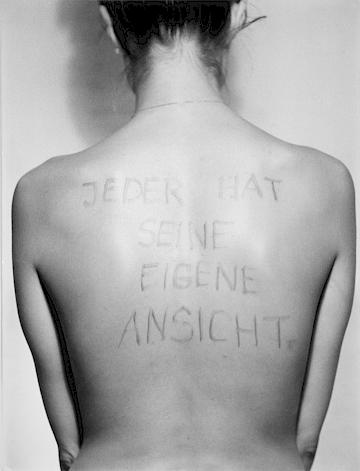 (1979, Everybody Has Their Own View) is a parody of the genre of the nude from the rear, which gained a lot in popularity in modernism: Jürgenssen poses with her back to the camera, up close, undressed, with no hint of any activity, such as washing, the nape of her neck free yet concealing. More demure than on the offensive, her arms held virtuously at her sides, she presents her back, on which is written not Jede hat ihre (feminine) eigene Ansicht but Jeder hat seine (masculine) eigene Ansicht. This nude from the rear functions like a stop sign: everyone gets the view (Ansicht) they deserve - a bare plane is all that is presented to the consuming gaze. This refusal, however, is not so much self-empowering as self-ironic, given that the obvious turn-of-phrase - "to have a head of your own," or to be stubborn in your views - is supported here by a frame that only partially includes the head. This dual reading of the term Ansicht (view) as something to look at, a face, and a view, not to mention a reputation (Ansehen), is thus ironically transfixed and confirms Laura Mulvey's "to-be-looked-at-ness 8 by means of a reversal. Furthermore, the face here seems to cast a monstrous shadow, while the body does not: pictorial individuality, being a person, appear to be diffused. The work Ich möchte hier raus (ph17)
(1979, Everybody Has Their Own View) is a parody of the genre of the nude from the rear, which gained a lot in popularity in modernism: Jürgenssen poses with her back to the camera, up close, undressed, with no hint of any activity, such as washing, the nape of her neck free yet concealing. More demure than on the offensive, her arms held virtuously at her sides, she presents her back, on which is written not Jede hat ihre (feminine) eigene Ansicht but Jeder hat seine (masculine) eigene Ansicht. This nude from the rear functions like a stop sign: everyone gets the view (Ansicht) they deserve - a bare plane is all that is presented to the consuming gaze. This refusal, however, is not so much self-empowering as self-ironic, given that the obvious turn-of-phrase - "to have a head of your own," or to be stubborn in your views - is supported here by a frame that only partially includes the head. This dual reading of the term Ansicht (view) as something to look at, a face, and a view, not to mention a reputation (Ansehen), is thus ironically transfixed and confirms Laura Mulvey's "to-be-looked-at-ness 8 by means of a reversal. Furthermore, the face here seems to cast a monstrous shadow, while the body does not: pictorial individuality, being a person, appear to be diffused. The work Ich möchte hier raus (ph17)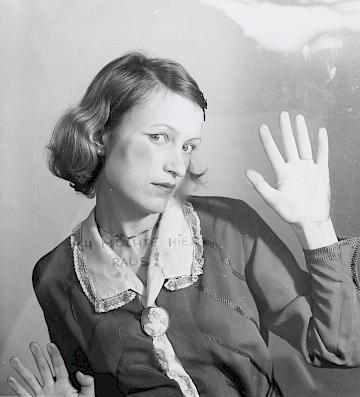 (1976, I Want to Get Out of Here!) also operates with a surface that can be written on, in this case a transparent border - today we speak of glass ceilings that ascribe a field of action to women. The script is on a glass door behind which is Birgit Jürgenssen, smart yet conservatively dressed, in a grotesquely timid pose, unable to cross this threshold (alone) into the public sphere. 9 Her hands, nose, and cheek are pressed against the obstruction, appearing like the reverse of the slightly raised female figure on her brooch. Her cheek forms a circular spot in the same format as the brooch, producing, together with the coquettish helplessness, a clown's face: the attempt to free herself appears to have been thwarted, just like that of Gelsomina in Fellini's La Strada vereitelt.
(1976, I Want to Get Out of Here!) also operates with a surface that can be written on, in this case a transparent border - today we speak of glass ceilings that ascribe a field of action to women. The script is on a glass door behind which is Birgit Jürgenssen, smart yet conservatively dressed, in a grotesquely timid pose, unable to cross this threshold (alone) into the public sphere. 9 Her hands, nose, and cheek are pressed against the obstruction, appearing like the reverse of the slightly raised female figure on her brooch. Her cheek forms a circular spot in the same format as the brooch, producing, together with the coquettish helplessness, a clown's face: the attempt to free herself appears to have been thwarted, just like that of Gelsomina in Fellini's La Strada vereitelt.
Ladylike attributes are also used in Selbst mit Fellchen (ph679)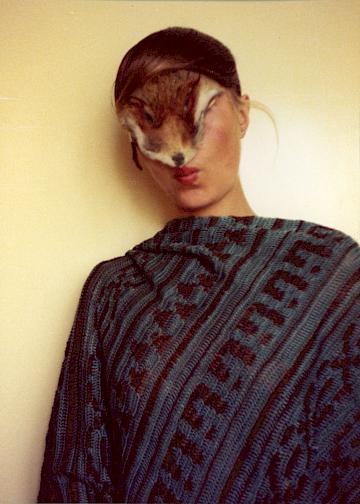 (1977/78, Self with Little Fur; Estate No. ph679). The diva-esque torso covered in a wrap is crowned by an animal-like head. The hair, arranged in a kind of fur bonnet, blends into an animal mask that was once part of a fox-fur scarf - trophy of the Alpine middle-class wife - and is extended by Jürgenssen's pouting red mouth. What is being addressed here is not some regressive ecstatic "becoming-animal," but rather the taming of the heroine or femme fatale, her transformation into a doll-like lady. Correspondingly, the stoically worn wrap is more like a piece of rough textile. In the same way, the matted fur in the photograph entitled Nest (ph761)
(1977/78, Self with Little Fur; Estate No. ph679). The diva-esque torso covered in a wrap is crowned by an animal-like head. The hair, arranged in a kind of fur bonnet, blends into an animal mask that was once part of a fox-fur scarf - trophy of the Alpine middle-class wife - and is extended by Jürgenssen's pouting red mouth. What is being addressed here is not some regressive ecstatic "becoming-animal," but rather the taming of the heroine or femme fatale, her transformation into a doll-like lady. Correspondingly, the stoically worn wrap is more like a piece of rough textile. In the same way, the matted fur in the photograph entitled Nest (ph761)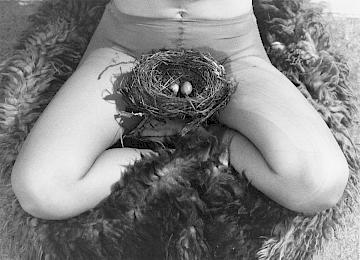 (1979) seems more grubby than threatening.
(1979) seems more grubby than threatening.
Here Jürgenssen presents a view of her pelvic area sheathed in silk stockings and lodged in a nest holding two small bird's eggs. The artist leaves us to wonder about the perfidiously constructed link between sexualization and protectedness. The seam of the stockings, the navel, and the eggs in the nest blend into a surprising inter-sexual sign, as astonishing as the sight of what has been born and the surely difficult maternity: the nest casts a clear shadow back over the genital area. Where in Aktionshose: Genitalpanik (1969, Action Pants: Genital Panic) or in Body Sign B (1970) Export not only poses with legs apart brazenly thwarting male-connoted genital aggressiveness and disparagingly presenting the apparatus of female seduction, which does not even have to be handled, as a brand mark on her own body, 10, Jürgenssen finds a melancholic, as it were, formula which again renounces the gender parity announced in the preliminary drawing in the sense of a compensation.
The treatment of imposed reproductive duties is totally grotesque in Hausfrauen-Küchenschürze (ph1578)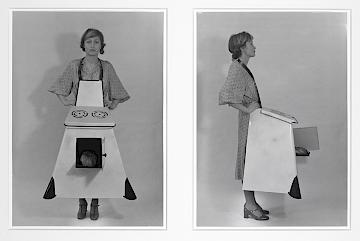 (1975, Housewives-Apron), where cooking and baking are equated with pregnancy and giving birth, and the housewife is presented as a mythical figure who, for the record, so to speak, is captured in a series of front and profile shots. The cooker has become a flattering appliance resting against the woman's body. The apron has become an object, a kind of vendor's tray containing - in the oven - a loaf of bread, as the body's fruit. Like Louise Bourgeois in her paintings and drawings of Femmes-maisons (1946/47) or Meret Oppenheim in her Robes de Diner (1942-45) 11 , where the wearable dress becomes a set table, Jürgenssen reflects here on the threatening appropriation of casings or appliances, the naturalization and incorporation of homeliness. She also caricatures the ambiguous demands made of the housewife, which is not just a professional designation: the male wish for a sexually attractive cleaning woman finds a response in the drawing Bodenschrubben (z402)
(1975, Housewives-Apron), where cooking and baking are equated with pregnancy and giving birth, and the housewife is presented as a mythical figure who, for the record, so to speak, is captured in a series of front and profile shots. The cooker has become a flattering appliance resting against the woman's body. The apron has become an object, a kind of vendor's tray containing - in the oven - a loaf of bread, as the body's fruit. Like Louise Bourgeois in her paintings and drawings of Femmes-maisons (1946/47) or Meret Oppenheim in her Robes de Diner (1942-45) 11 , where the wearable dress becomes a set table, Jürgenssen reflects here on the threatening appropriation of casings or appliances, the naturalization and incorporation of homeliness. She also caricatures the ambiguous demands made of the housewife, which is not just a professional designation: the male wish for a sexually attractive cleaning woman finds a response in the drawing Bodenschrubben (z402)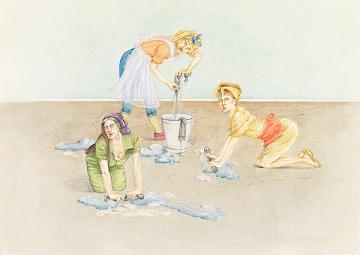 (1974) Scrubbing Floors) which has a cheerfully sadistic gesture according to which the cleaning rags to be wrung out are small spouses in the official dress. 12
(1974) Scrubbing Floors) which has a cheerfully sadistic gesture according to which the cleaning rags to be wrung out are small spouses in the official dress. 12
These works are a reaction to the postwar "back to the kitchen sink" policy. The humorous potential of the photographs clearly refers to the distribution of social power and the respective conventions of presentation, and not to the possibly liberating aspect of various constructions of identity. Housewives, mothers, and ladies are presented critically, and that at a point in time when the second women's movement in Austria was focusing on Social Democratic family law reform (1975-78) and actually notching up its first de facto political successes. 13
Parallel to this, the autonomous women's movement, with its aspiration to a complete social change in the direction of post-capitalist and post-patriarchal forms of living working, was beginning to develop a whole scenario of women's projects. 14 Women artists too were organized around the Grita Insam Gallery; the first women's exhibitions were mounted, for example Valie Export's Magna. Feminismus: Kunst und Kreativität, 15 in which Birgit Jürgenssen was also represented alongside Meret Oppenheim, Maria Lassnig, Friederike Pezold, Cora Pongracz, and many others; IntAkt, the Internationale Aktionsgemeinschaft bildender Künstlerinnen (Active Association of Women Visual Artists), was founded in 1977, in the early eighties the Verein Frauen 84, which was co-founded by the then state secretary Johanna Dohnal together with Valie Export. The group organized the international exhibition Kunst mit Eigen-Sinn (Art with Obstinacy) in the Vienna Museum of the Twentieth Century.Women artists fought to be represented in exhibitions and collections, for an equal number of grants and public commissions, for teaching posts and positions at art academies. In terms of content, the discussions of those years were colored by the issue of the extent to which exhibitions of women's art promoted or ghettoized women artists, the extent to which one could speak of a female or feminist art and aesthetic. 16 In addition to the artistic engagement with corporeality and sexuality on the one hand, and female authorship on the other, the pictorial solutions primarily criticized the social positioning of the genders.
The mainly Anglo-American critique of the Untitled Film Stills, by contrast, was and is characterized by an engagement with fetishization and masquerade. It has recourse to psychoanalytical theories about female desire which hover between deficiency and substitute formation, the veiling of sexual identity and the appropriation (of the phallus). 17 The offensive attitude with which Sherman put femininity on show as a masquerade, a chameleon-like adaptation of identity to the given economics of gaze and desire, was therefore evaluated differently: as a continuation of a misogynous reality in which substitution could not be avoided, as a post-modern caricature of essentializing feminist art and theories, but also as a subversive appropriation of the male gaze, as a disturbing attack on the order of seeing and being seen. 18. The series Sherman produced in the nineteen-eighties--her work with physical decline, the abject and monstrous, the threatening inside of the masquerade--made up for the excessive emphasis on voyeuristic structures: the savoring of the exposure of the commodity aspect of masked female surfaces, of superficial womanhoods, enabled the gaze to be directed at vulnerability and torpedoed the fetishization process. According to Laura Mulvey, the Untitled Film Stills allow us to experience the gap between knowledge and belief, the structure of the "I know, but . . . " that constitutes the fetishization. The development on from the Untitled Film Stills to the so-called bulimia images allows us to uncover the traumatic experience of castration and castration-anxiety and to defetishize it by revealing the wound--and the imperviousness of American nineteen-fifties myths to reality. 19 Accordingly the Untitled Film Still are a post-feministic articulation of pre-feminist images of womanhood. While Laura Mulvey understands the proliferation of possible subject-positions as a reference to their fundamental instability and so argues at the level of identity-formation, Rosalind Krauss, who responds in a kind of discourse abjection, wants to place the gap between knowledge and belief fully on the side of post-modern irritation with regard to the status of photographs as copies without an original. By directing attention to the process of signification itself, images of womanhood in the nineteen-fifties are demystified and thereby re-politicized. "Womanhood" is thus not superficially indebted to masquerade and staging, rather "it" proves to be a function in a chain of signification involving, at one and the same time, mask, positioning, lighting, depth of field, viewpoint, and camera angle. Sherman's enterprise therefore aims not at the precise reconstruction of types or characters from the world of cinema, nor at a pictorial politics of the body, but at a de-fetishization of the signified--also of the woman as signified. 20 Here we have come full circle to Constructivist theory, in which gender identities are understood as discursive constructs that are fully resolved in representation, where gender identity itself is understood as a copy without an original. 21
For her nineteen-seventies works in which she was preoccupied with the relationship between representation and womanhood, Birgit Jürgenssen also received the label "post-feminist." 22 She is said to have explored the "sign woman" and been concerned with "reflections on possible configurations of identity constructions and subversive acts related to psychosexual identity." 23 This can be accepted as an anachronistic monopolization, taking into account the discourse history according to which the debate in her time and area was not about codifying, but about ascriptions, not about masquerade but role clichés. If one is to do justice to Jürgenssen's specific pictorial wit, then the figure of clowning seems more suitable for characterizing her works, considering that irony is valid as a trope of fetishism, This can be accepted as an anachronistic monopolization, taking into account the discourse history according to which the debate in her time and area was not about codifying, but about ascriptions, not about masquerade but role clichés. If one is to do justice to Jürgenssen's specific pictorial wit, then the figure of clowning seems more suitable for characterizing her works, considering that irony is valid as a trope of fetishism, 24 that clowning and masquerading also meet head-on in the discourse of hysteria. 25
When once asked about irony as a major quality of her works, Jürgenssen replied: "I don't know if it is irony. It is distance, and the distance that impacts my work has to do with the fact that I grew up with role clichés [...] I wouldn't call it camouflage. In my case it is rather a surreal practice of making visible by veiling. However, I use masks because it is not so much about me as the situations in which I present myself, the stories that are being made visible. And in any case, about slipping into other roles and identities." 26 The silly clown as the successor of the fool, rogue or rascal acts in a narrative framework, "muddles through," is disobedient, articulates him/herself through irony and parody; stuttering, silent, stumbling, in a masquerade of banality and stupidity that functions as a mirror. Clowns are opponents of the everyday worldly and symbolic order--which can be embodied for example in a white clown--without being belligerent. They react in an apparently inappropriate way. Their tool is the distortion of language: they are so-called simple people who imitate a high-flown tone, who emphasize the ridiculous or take turns of phrase literally, as Jürgenssen does in Das Match, das trag ich mit mir selber aus (z30)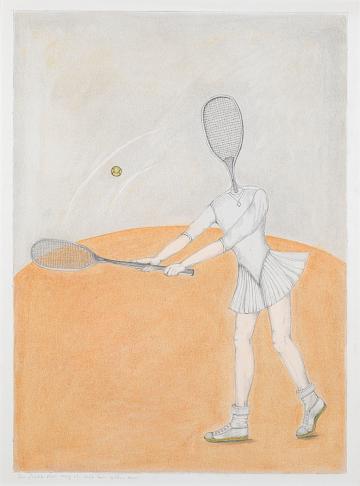 (1973, I'll Play the Match with Myself). As counter-figures, clowns disrupt normative regulations, even simple customs, they subvert logical conclusions and practicabilities, like Charlie Chaplin for example, who, in an obvious emergency, eats shoe laces like a grand seigneur instead of spaghetti; or the music clown Grock, who needless to say pushes the grand piano over to the piano stool. Moreover, the clowning can be characterized by a general mood of melancholy; the specifically comic aspect is determined by distraction, boredom, absurd failure, exclusion, and the comedy is mainly mediated through facial expressions or gestures and thus gets across the connection between language and domination. Male and female clowns, like hysterics, can therefore be understood as oppositional figures, whereby clowning as opposed to the grotesque is always endearing and often imbued with a sense of mutual dependence 27
(1973, I'll Play the Match with Myself). As counter-figures, clowns disrupt normative regulations, even simple customs, they subvert logical conclusions and practicabilities, like Charlie Chaplin for example, who, in an obvious emergency, eats shoe laces like a grand seigneur instead of spaghetti; or the music clown Grock, who needless to say pushes the grand piano over to the piano stool. Moreover, the clowning can be characterized by a general mood of melancholy; the specifically comic aspect is determined by distraction, boredom, absurd failure, exclusion, and the comedy is mainly mediated through facial expressions or gestures and thus gets across the connection between language and domination. Male and female clowns, like hysterics, can therefore be understood as oppositional figures, whereby clowning as opposed to the grotesque is always endearing and often imbued with a sense of mutual dependence 27
Jürgenssen and Sherman are both fools on the stage of patriarchy. The latter in particular with her early works, the Murder Mystery People (1977/78) and the Bus Riders (1976), 28 where in the one case stereotypical figures from a crime story, and in the other different commonplace types are presented in isolation. They do not (yet) parody the concept of the original as a gender identity, 29 but parody gender identities as inscriptions in a discriminating culture. Like Patricia Highsmith in her Little Tales of Misogyny (1977), where misogynist images, such as the middle-class housewife, the coquette, or the victim, are sarcastically exaggerated through a superficial naivety, these artists work with typifying masquerades, with narrative critique, not with performativity. In Untitled A, B, C, D, E (1975) Sherman also presents the figure of the clown, a figure primarily constituted by mime, a figure that in the history of culture is strongly associated with telling the truth in the social and political sphere. Clowns with their oafish exaggeration and their tricks perhaps hold out the last hope of authenticity. 30
The reverse of the theatrical clowning in Jürgenssen's works of the late nineteen-seventies is a more carnivalesque handling of the mask that echoes folk culture and late medieval painting. InTotentanz mit Mädchen (ph1340)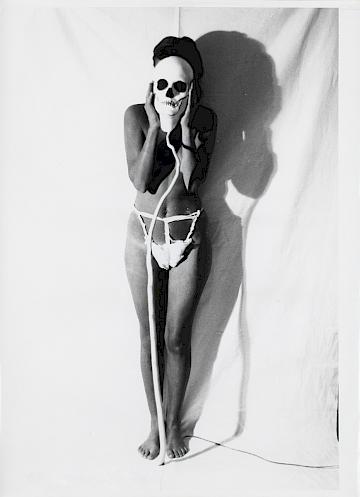 (1979, Dance of Death with Maiden) she uses a concept of the mask that really constitutes being-a-person in all its fleetingness. It is a mask than can be put on and taken off, that can be used as an Other, and also to conceal. As the respective third person, the monstrous shadow syntheticizes in its dis-embodiment the confrontation between the girl--naked or wrapped in cloth when menstruating--and the mask of death--all three, however, against a vertical winding-sheet and together figuring a vera icon.
(1979, Dance of Death with Maiden) she uses a concept of the mask that really constitutes being-a-person in all its fleetingness. It is a mask than can be put on and taken off, that can be used as an Other, and also to conceal. As the respective third person, the monstrous shadow syntheticizes in its dis-embodiment the confrontation between the girl--naked or wrapped in cloth when menstruating--and the mask of death--all three, however, against a vertical winding-sheet and together figuring a vera icon.
1) Birgit Jürgenssen. Früher oder später, exh. cat. Landesgalerie Oberösterreich (Vienna and Weitra, 1998).
2) See Birgit Jürgenssen. Schuhwerk. Subversive Aspects of "Feminism," exh. cat. MAK Museum für Angewandte Kunst Wien (Vienna 2004); Die Damen was the name of a humorous female quartet who caused a sensation on the Viennese art scene between 1987 and 1994: Ona B., Evelyne Egerer, Birgit Jürgenssen, and Ingeborg Strobl; when Ingeborg Strobl left the quartet in 1993 Lawrence Weiner joined as the fourth Dame. See Genta Chidori and Ona B., Die Damen (Vienna, 1994).
3) According to Hubert Winter this is a double exposure. I would like to thank Hubert Winter for allowing me to study material from the artist's estate.
4) See for example Norma Broud and Mary D. Garrard (eds.), The Power of Feminist Art. The American Movement of the 1970s, History and Impact (New York, 1994); Silvia Eiblmayr et al. (eds.), Kunst mit Eigen-Sinn. Aktuelle Kunst von Frauen. Texte und Dokumentation (Vienna and Munich, 1985).
5) Rosalind Krauss, Cindy Sherman. 1975-1993 (New York, 1993). See the essays by Abigail Solomon-Godeau and Gabriele Schor in this catalogue.
6) Birgit Jürgenssen in conversation with Rainer Metzger in Kunstforum International, 164 (2003), p. 245.
7) See for example a title such as that by Fritz Franz Vogel, The Cindy Shermans. Inszenierte Identitäten. Fotogeschichte von 1840-2005 (Cologne and Vienna, 2006).
8) This is how Mulvey understands the codification of woman through being looked at by a male opposite or observer. Id., Visual and Other Pleasures (Bloomington, Ind., 1989), p. 19.
9) Variations exist of both Jeder hat seine eigene Ansicht and Ich möchte hier raus; the first in a frame that includes the head, the second with the reproduction of a door handle.
10) See Valie Export, exh. cat. Centre national de la photographie, Paris (Paris, 2003), pp. 14-15, and my article on Valie Export in this catalogue, pp. 152-159.
11) Bourgeois' works can also be understood in connection with the place of memories and primal scenes. See Marie-Laure Bernadac, Louise Bourgeois (Paris and New York, 1996), pp. 23-28; Thomas Levy (ed.), Meret Oppenheim. From Breakfast in Fur and Back Again. The Conflation of Images, Language, and Objects in Meret Oppenheim's Applied Art (Bielefeld, 2003), pp. 114-115.
12) This drawing was re-staged by Die Damen in 1990 for a calendar published by the Österreichische Tabakwerke--accordingly, the gender-specific division of labor was experienced as lasting. See Chidori 1994 (see note 2), no page number.
13) The following had been achieved: sickness benefit; days off also for men to take care of sick persons; special benefits for unemployed single mothers; introduction of the concept of partnership-marriage establishing the principle of a co-responsibility for men for the upbringing of children and for housework; abolition of a wife's duty to move to her husband's residence; decriminalization of abortion and introduction of the so-called legal upper time limit in 1975; the 1979 law on equal pay for men and women for equal work, and a cabinet resolution on the quota regulation aiming at 25 percent women. See Marion Wisinger, Land der Töchter. 150 Jahre Frauenleben in Österreich (Vienna, 1992), pp. 189-190.
14) Autonomous institutions for violently abused women were set up, as were educational and cultural projects. See Brigitte Geiger and Hanna Hacker, Donauwalzer Damenwahl. Frauenbewegte Zusammenhänge in Österreich (Vienna, 1989).
15) Magna. Feminismus: Kunst und Kreativität. Ein Überblick über die weibliche Sensibilität, Imagination, Projektion und Problematik, suggeriert durch ein Tableau von Bildern, Objekten, Fotos, Vorträgen, Diskussionen, Lesungen, Filmen, Videobändern und Aktionen, compiled by Valie Export, Galerie Nächst St. Stephan (Vienna, 1975).
16) See Sylvie Aigner, "Eigen-Sinn und Gruppengeist. Das Jahrzehnt der Frauen von 1975 bis 1985," in Künstlerinnen. Positionen 1945 bis heute. Mimosen--Rosen--Herbstzeitlosen, exh. cat. Kunstmeile Krems (Krems 2003), pp. 104-114.
17) See Joan Rivière, "Weiblichkeit als Maskerade" (1929), in Liliane Weissberg (ed.), Weiblichkeit als Maskerade (Frankfurt am Main, 1994), pp. 34-74; Jacques Lacan, "Die Bedeutung des Phallus" (1966), in Norbert Haas and Hans-Joachim Metzger (eds.), Jacques Lacan. Schriften II. (Weinheim and Basel, 1986), pp. 119-132. Rivière understands womanhood as a mask which transforms rivalry into a gesture of subjection so as to excuse castration--accordingly, the masquerade functions as a making-oneself-small, in the sense of making amends, of a reaction formation. By contrast, Lacan describes the relationship of the woman to the phallus-signifier as a masquerade, a paradoxical structure: by the woman being the phallus as a desired object or Other, she indicates the lack--the cause of the castration anxiety. "Is the masquerade the consequence of a female desire that had to be masked and thus was transformed into a lack that now has somehow to come to light? Or does it follow from that fact that this lack is denied so as to pretend to be the phallus?" Judith Butler. Das Unbehagen der Geschlechter (Frankfurt am Main, 1991), p. 80.
18) The multifaceted discussion can be traced in Krauss 1993 (see note 5) and Laura Mulvey, "A Phantasmagoria of the Female Body: The Work of Cindy Sherman," New Left Review 188 (1991), pp. 136-150. On the denial of a feminist reading see Abigail Solomon-Godeau, "Suitable for Framing: The Critical Recasting of Cindy Sherman," Parkett 29 (1991), pp. 112-121.
19) Mulvey 1991 (see note 18), pp. 145-148.
20) See Krauss 1993 (see note 5).
21) See Butler 1991 (see note 17), for example p. 215.
22) For example Metzger 2003 (see note 6), p. 237.
23) Doris Linda Psenicnik, Identität, Geschlecht und Konstruktion. Künstlerische Interventionen im Spektrum feministischer Strategien zu Fragen der Geschlechtsidentität. Mit einem Schwerpunkt auf dem fotografischen Oeuvre Birgit Jürgenssens. M.A. thesis (Graz, 2001), pp. 99-100, 104.
24) See Naomi Schor, "Fetishism and its Ironies," 19th Century French Studies, 17 (1988/89), p. 94. See Weissberg 1994 (see note 17), p. 18.
25) Lacan understands hysteria as a failure of the masquerade. Richter uses the term période de clownism in his tableau of the so-called major hysterical attack (1881) to describe the phase between epileptoid cramps and the "passionae attitudes," that is as a kind of hysterical hysteria that is beyond classification. See Georges Didi-Huberman, Erfindung der Hysterie. Die photographische Klinik von Jean-Martin Charcot (Munich, 1997), fig. 46 and p. 295.
26) Birgit Jürgenssen in conversation with Rainer Metzger. A slightly altered printed version was reproduced in "Es ist Selbstironie," in Jürgenssen and Metzger 2003 (see note 6), pp. 235, 243.
27) See Constantin von Barloewen, Clown. Zur Phänomenologie des Stolperns (Frankfurt am Main, 1984).
28) See the essay on Sherman in this catalogue pp. 44-71.
29) See Butler 1991 (see note 17), p. 203.
30) When questioned about her 2003 Clowns series, Sherman replied: "... I wanted to find something behind the make-up, so to speak, something strange that shines through." In "Ohne Make-up. Ein Interview von Cindy Sherman mit Isabelle Graw, " in Cindy Sherman. Clowns exh. cat. Kestner-Gesellschaft, Hannover (Munich, 2004), p. 44.